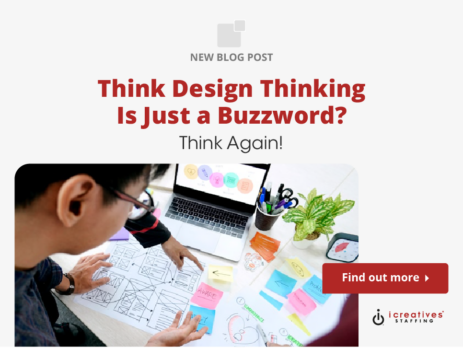Think Design Thinking Is Just a Buzzword? Think Again!
When the term “Design Thinking” is thrown around in conferences, workshops, or corporate meetings, many may dismiss it as just another fleeting industry buzzword. However, this could not be further from the truth. Design Thinking is a robust, user-centered approach to problem-solving and innovation. This framework goes beyond traditional boundaries, encouraging creative solutions to complex problems across all sectors from tech to education, and healthcare.
Firstly, Design Thinking isn’t new; it has evolved over decades, rooting itself deeply in the ethos of designers’ approach to creating solutions. The methodology is structured yet flexible, consisting of five phases: Empathize, Define, Ideate, Prototype, and Test. This process is iterative, meaning that it cycles through these stages multiple times to refine solutions, making it exceptionally adaptive to feedback and changing conditions.
What sets Design Thinking apart is its core principle of empathizing with users. Unlike more conventional strategies that start with a solution in mind, Design Thinking begins with understanding the experiences and challenges of real people. This change in perspective can lead to more innovative and practical outcomes than traditional problem-solving methods might overlook.
Moreover, Design Thinking fosters a culture of collaboration among cross-functional teams, leveraging diverse perspectives to uncover hidden insights and solutions. This inclusive approach breaks down silos within organizations, promoting a blend of ideas that can cater to broader user needs and boost innovation.
In reality, embracing Design Thinking can drive businesses forward, leading to products and services that genuinely resonate with users. As we delve deeper, we’ll explore common questions surrounding Design Thinking, proving it’s far more substantial than mere buzzword status.
1. What is Design Thinking and why is it considered effective?
Design Thinking is a methodology primarily used for problem-solving and fostering innovation. At its core, this approach works to better understand the user’s needs through a human-centered perspective. Its effectiveness is largely attributed to its iterative process involving five key phases: Empathizing with users, defining the problems, ideating solutions, prototyping, and testing. Each phase builds on the one before with repeated cycles to refine and enhance the solutions based on real user feedback and insights.
One of the reasons Design Thinking is considered effective is because it encourages a deep understanding of the users for whom products are designed. It pushes teams to explore not just the obvious answers but to ask new questions about user behaviors, needs, and possible obstacles. This usually leads to more innovative solutions that traditional problem-solving methods may not achieve.
The process also promotes collaboration across various disciplines, bringing together diverse perspectives that might not intersect in standard operations. This confluence of different specialties – from engineering to UX design, to marketing – creates a fertile ground for novel ideas and unexpected solutions, enhancing the potential for groundbreaking innovations.
Prototyping, a central element of Design Thinking, allows teams to visualize and test their ideas quickly and cheaply before extensive implementation efforts and costs are incurred. This minimizes the risks associated with launching new products or services, as iterations are based on continuous user feedback looped into the development process.
Ultimately, the effectiveness of Design Thinking lies in its user-centered approach, which places real human needs and responses at the forefront of product and service development. This aligns products closely with market demands and has shown to improve success rates in various industries globally. Interested in how it integrates with user experience design? Delve further into how UX and UI work together using Design Thinking principles on our blog.

2. How does Design Thinking differ from traditional problem-solving methods?
While traditional problem-solving methods typically focus on directly advancing from problem identification to solution development, Design Thinking introduces a fundamentally different approach: the integration of empathizing with users into the core of the process. This shift not only focuses on creating solutions that are operationally effective but also ensures that these solutions are devised with a deep understanding of the user’s context and needs.
The traditional methods often operate under well-defined parameters and seek to optimize or improve existing solutions. Conversely, Design Thinking encourages exploring a broader spectrum of potential solutions through an iterative, nonlinear process. By continuously cycling through its five stages, this approach is able to adapt more dynamically to new information and changing user requirements, which traditional methods might not handle as flexibly.
Key to its distinctiveness is also the ideation phase in Design Thinking where brainstorming and creative thinking are encouraged to generate a wide array of ideas. This is significantly different from traditional methods that might limit thinking to known frameworks or logical continuations of existing products or services. Through this expansive ideation process, Design Thinking can uncover innovative approaches that completely reinvent the existing landscapes of industries.
Furthermore, prototyping in Design Thinking is not merely a step to create a functional product, but a tool for learning and understanding. Prototypes are developed rapidly based on the ideas generated, and they are tested and iterated upon with real users. This feedback-centric loop, often absent in traditional problem-solving, helps in refining solutions to better suit user needs even before full-scale development begins.
By prioritizing these elements, Design Thinking fosters a more agile and responsive approach to problem-solving that can lead to more effective and user-friendly solutions. Innovators interested in further exploring how these practices differ from typical industry myths can benefit from debunking common UI/UX myths.
3. Which industries benefit most from implementing Design Thinking?
Design Thinking is versatile and can be applied across a wide range of industries. However, certain sectors benefit particularly from its user-centric approach and iterative methodology. These include technology, healthcare, education, and financial services, where innovation and user experience are crucial for success.
In the technology sector, Design Thinking helps in developing products that are not only technologically advanced but also user-friendly. Companies like Apple and Google use Design Thinking to create innovative products that meet real user needs. For instance, the iterative process of prototyping and testing ensures that the final products are well-tuned to user preferences and usability standards.
Healthcare is another industry where Design Thinking can have a significant impact. By focusing on the patient experience, medical professionals and organizations can develop solutions that are more empathetic and effective. This could range from improving the usability of medical devices to designing better patient care processes that enhance patient satisfaction and outcomes.
Education benefits from Design Thinking by fostering more engaging and effective learning experiences. Schools and educational technology companies are using this approach to design curriculums and products that cater to diverse learning styles and needs, making education more accessible and impactful.
Financial services, including banking and insurance, are turning to Design Thinking to improve customer service and develop new products. By understanding the real needs and pain points of consumers, companies can create solutions that offer better user experiences, such as easier mobile banking apps or more personalized insurance plans.
These industries, among others, find great value in Design Thinking because it leads to innovations that are not only technically sound but also deeply resonate with users. For more insights into how Design Thinking is transforming professional practices, check out the complete guide to game UX.
4. What are the common challenges in implementing Design Thinking?
While Design Thinking offers numerous benefits, implementing it can come with challenges. One of the primary hurdles is the cultural shift required within organizations. Moving from a traditional, hierarchical decision-making process to a more collaborative, iterative approach can be difficult for teams accustomed to conventional workflows.
Another challenge is the need for a deep understanding of users, which requires effective research and empathy. Organizations must invest in training their teams to adopt empathy-driven methods to truly understand and anticipate user needs. This often involves acquiring new skills or adapting existing ones, which can be a significant transition for any team.
Time constraints can also pose a challenge. The iterative nature of Design Thinking means that multiple prototypes and rounds of testing are necessary, which can be time-consuming. Balancing quick decision-making with thorough exploration and refinement of ideas is a common struggle for companies racing against tight deadlines.
Additionally, measuring the success of Design Thinking projects can be complex. Traditional metrics may not effectively capture the holistic benefits of the approach, such as increased user satisfaction or enhanced team collaboration. Developing new metrics that reflect the true value added by Design Thinking is crucial for its sustained implementation.
Despite these challenges, the adoption of Design Thinking continues to grow as more organizations recognize its potential to drive innovation and create more user-centric products and services. For those looking to explore further, discover the benefits of hiring remote illustrators to boost your brand’s image.
5. How can organizations cultivate a Design Thinking culture?
To successfully implement Design Thinking, organizations must cultivate a culture that supports its principles. This involves fostering an environment of collaboration, experimentation, and user-centricity.
Leadership commitment is crucial. Leaders must advocate for and practice Design Thinking principles, setting an example for the rest of the organization. They should encourage experimentation and be accepting of failures as part of the learning process.
Training and resources are also vital. Providing teams with the tools and knowledge they need to employ Design Thinking effectively is essential. This might include workshops, seminars, and access to user research tools.
Moreover, promoting cross-functional teams can enhance the effectiveness of Design Thinking. By bringing together diverse perspectives from different departments, organizations can uncover unique insights and drive more comprehensive innovation.
Finally, creating feedback loops with real users is essential. Regularly testing ideas with users and incorporating their feedback helps ensure that solutions are truly aligned with user needs and enhances the overall effectiveness of the Design Thinking process.
By addressing these areas, organizations can create a fertile ground for Design Thinking to thrive, leading to more innovative and user-friendly solutions. For additional strategies on professional growth in this field, consider exploring top secrets to kickstart your professional profile in graphic design.
Conclusion
Design Thinking is far from being just a buzzword; it’s a transformative approach that has reshaped how industries tackle problems and innovate. By focusing on human-centered design, fostering collaboration, and embracing iterative processes, Design Thinking helps create solutions that are not only effective but deeply resonate with users.
The journey to integrating Design Thinking into an organization’s fabric can be challenging but ultimately rewarding. It requires a shift in mindset, dedicated resources, and a commitment to continuous learning and adaptation. However, the benefits of such an approach—increased innovation, better user experiences, and more agile responses to market changes—are well worth the effort.
As businesses and industries continue to evolve, the principles of Design Thinking remain relevant, providing a solid foundation for creating the innovative solutions needed in today’s fast-paced world. Embracing this approach can lead to significant competitive advantages and sustained success.
For those looking to dive deeper into the nuances of user experience and interface design, further exploration into the top 10 UX/UI design tools every designer swears by in 2025 can provide additional insights and tools to enhance your skills in this dynamic field.
In today’s competitive market, finding the right creative and marketing expert can be a challenge. But with icreatives, you’re in experienced hands. With 37 years in staffing and a track record of matching more than 10,000 employees to over 1,000 companies worldwide, we know how to connect you with the best. Plus, you only pay if you hire—there’s no risk, only results. Ready to find your perfect creative or marketing expert? HIRE WITH ICREATIVES today!












